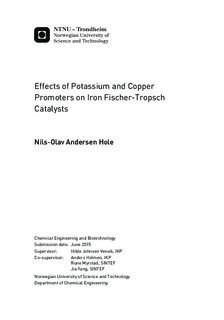Effects of Potassium and Copper Promoters on Iron Fischer-Tropsch Catalysts
Master thesis
Permanent lenke
http://hdl.handle.net/11250/2351712Utgivelsesdato
2015Metadata
Vis full innførselSamlinger
Sammendrag
The demand for energy is an ever increasing problem in the world today. The need for more abundant energy sources to take over the role of crude oil is becoming more and more present. GTL processes (gas-to-liquid), which utilizes the natural gas resources, are interesting replacements for the production of fuels in the future. One GTL process,the Fischer-Tropsch synthesis (FTS), produces fuel precursors by reacting a gaseous stream consisting of carbon monoxide and hydrogen. The objective in this thesis was the fabrication of iron catalysts to enhance the production of desired products of the Fischer-Tropsch synthesis. Products like long chained hydrocarbons and olefins are desired, because they can later be refined into fuels like petrol and diesel. The effects of different promoter materials were studied, and it was decided to prepare the iron catalysts with small amounts of potassium and copper. All catalysts were prepared using the incipient wetness method with alumina support. In addition to testing the catalysts in a Fischer-Tropsch rig, the catalysts were also characterized using CO chemisorption and physisorption. Some of the catalysts did not disperse the iron well on the support surface. This could indicate the metal piling up in multiple layers on the surface. One reason for this could be the method of preparation, with drying and calcining after each impregnation step. Potassium proved to be the promoter material with largest implications regarding selectivity towards long chained hydrocarbons and olefins. Copper was originally added to yield higher activities and conversionrates for the catalysts, but these effects did not show for the experiments. It was instead another factor, namely a higher amount of iron in the catalysts, which proved to have the greatest impact on conversionrates. Most of the catalysts run in the Fischer-Tropsch rig were activated with hydrogen at high temperatures. Two catalysts were in addition activated with synthesis gas, and though they had high selectivities towards olefins, these came at very low activities.
